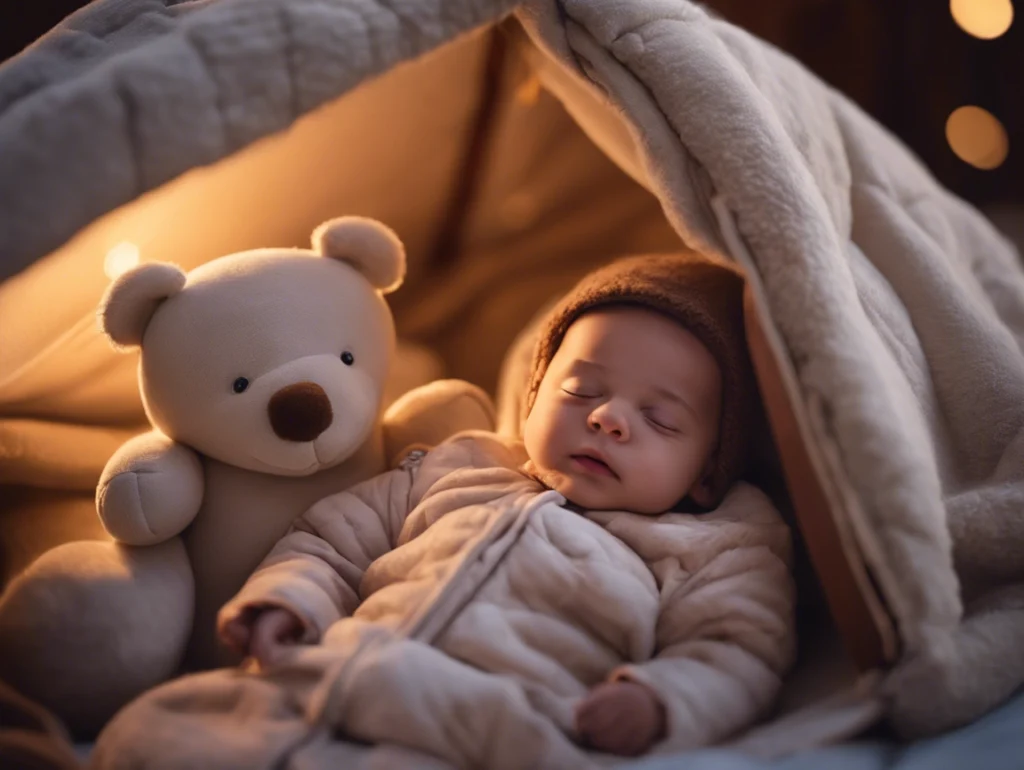Because babies can’t tell us if they’re too hot or too cold, but they sure know how to let us know when they’re uncomfortable!
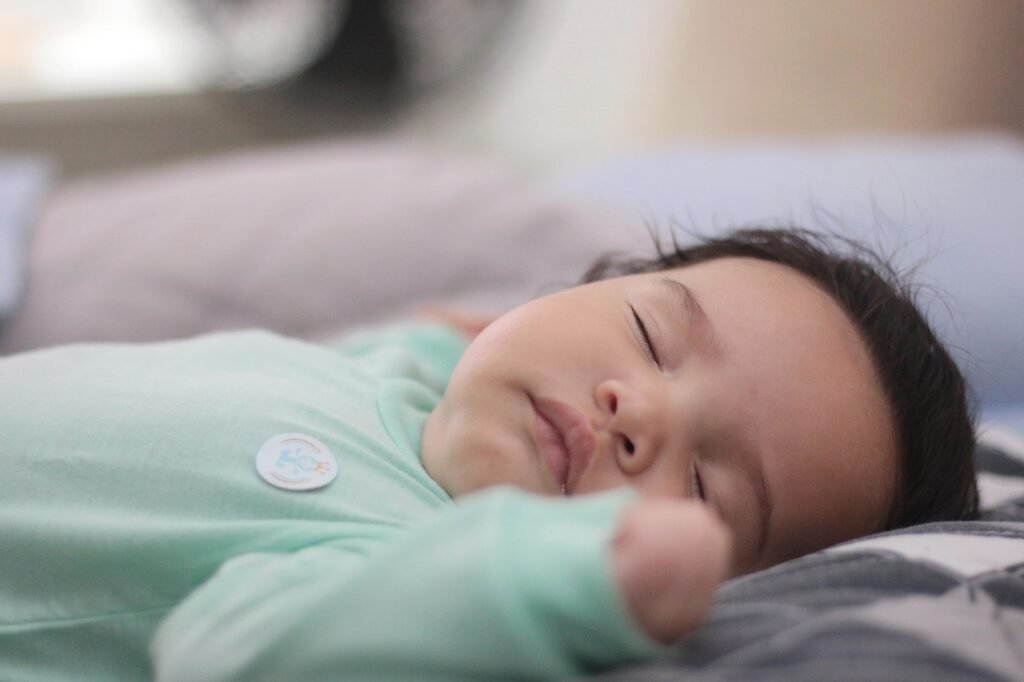
As parents, we often find ourselves asking the age-old question: Is my baby too hot or too cold? It’s like we’re Goldilocks, but instead of porridge, we’re dealing with room temperatures and tiny humans who can’t speak yet. Enter the baby sleeping sack—a game-changer in ensuring your little one sleeps safely and comfortably through the night, no matter the season.
Choosing the right sleeping sack isn’t just about picking the cutest pattern (though we all know that’s important, too). It’s about understanding how different climates and seasons affect your baby’s sleep and how the correct sleeping sack can help regulate their temperature. So, let’s dive into the cozy world of sleeping sacks and find the perfect match for every season!
Table of Contents
- Understanding Sleeping Sacks and TOG Ratings
- Seasonal Considerations
- Summer Sweetness
- Autumn Adventures
- Winter Wonderland
- Spring Surprises
- Regional Climate Considerations
- Choosing the Right Material
- Tips for Using Sleeping Sacks in Different Climates
- Care and Maintenance
- Frequently Asked Questions (FAQs)
Understanding Sleeping Sacks and TOG Ratings
Before we embark on our seasonal journey, let’s get acquainted with the TOG rating—the not-so-secret code to your baby’s comfort.
What is a TOG rating?
TOG stands for “Thermal Overall Grade.” It’s a standardized unit of measurement for insulation and warmth of bedding materials, including sleeping sacks. Think of it as the “coziness factor.”
TOG Rating Guide:
| TOG Rating | Room Temperature | Description |
|---|---|---|
| 0.5 | 24°C and above (75°F and above) | For hot weather and heatwaves |
| 1.0 | Between 21°C – 24°C (69°F – 75°F) | For warm temperatures |
| 2.5 | Between 16°C – 20°C (61°F – 68°F) | For mild to cool temperatures |
| 3.5 | Below 16°C (Below 61°F) | For cold temperatures |
Key Takeaway: The higher the TOG rating, the warmer the sleeping sack.
Seasonal Considerations
Summer Sweetness
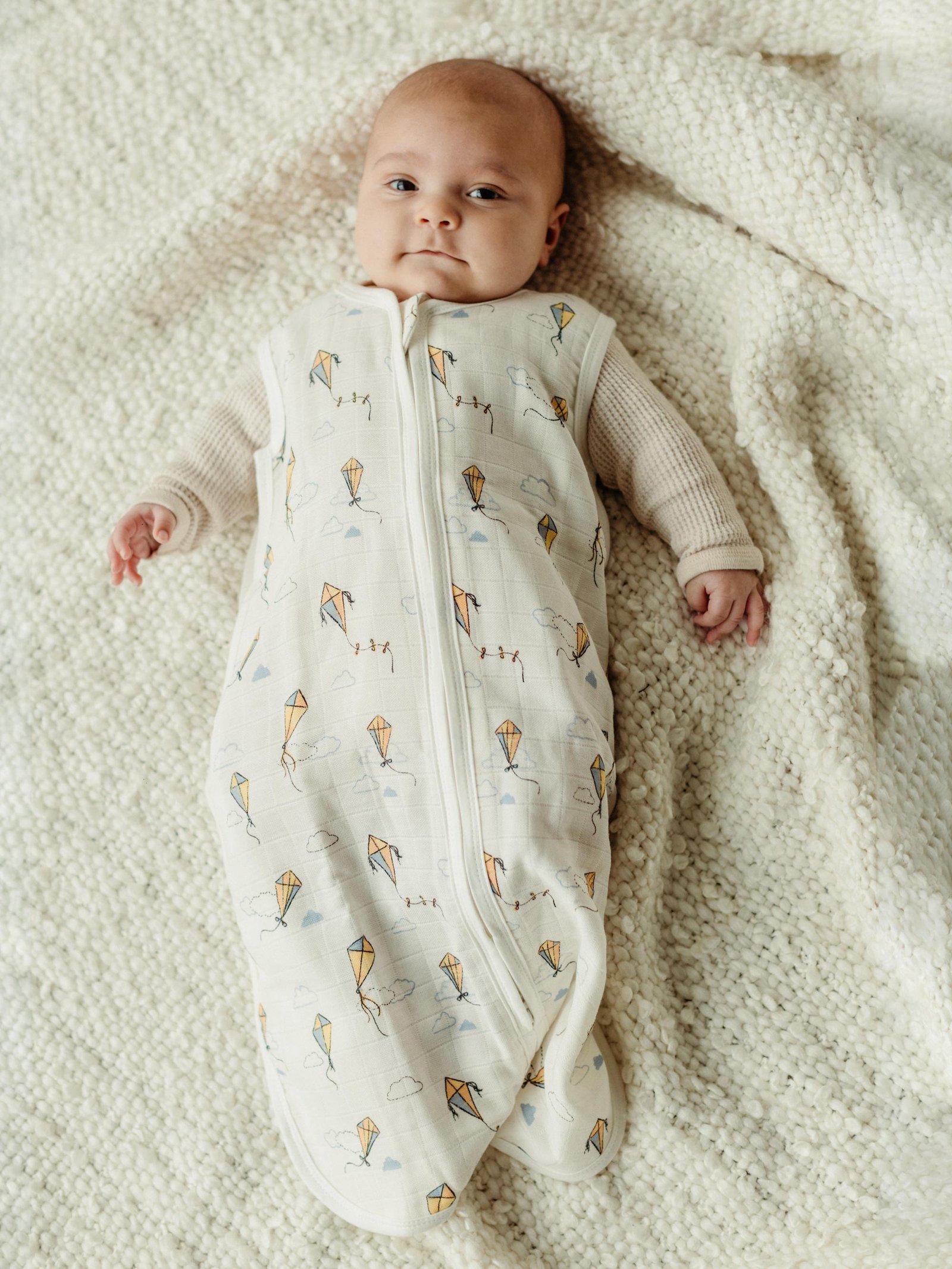
Summer brings sunshine, ice cream, and…sweaty babies? Let’s avoid the latter.
TOG Recommendations: Opt for a 0.5 TOG sleeping sack for those hot summer nights.
Material Choices:
- Muslin Cotton: Lightweight and breathable.
- Bamboo Fabric: Naturally temperature-regulating and soft.
Clothing Underneath:
- A simple short-sleeve onesie or even just a diaper if it’s particularly warm.
Tips:
- Keep the Room Ventilated: Use a fan (pointed away from the baby) to circulate air.
- Monitor Room Temperature: Ideal baby room temperature is around 24°C (75°F).
- Stay Hydrated: For older babies, ensure they’re getting enough fluids during the day.
Autumn Adventures
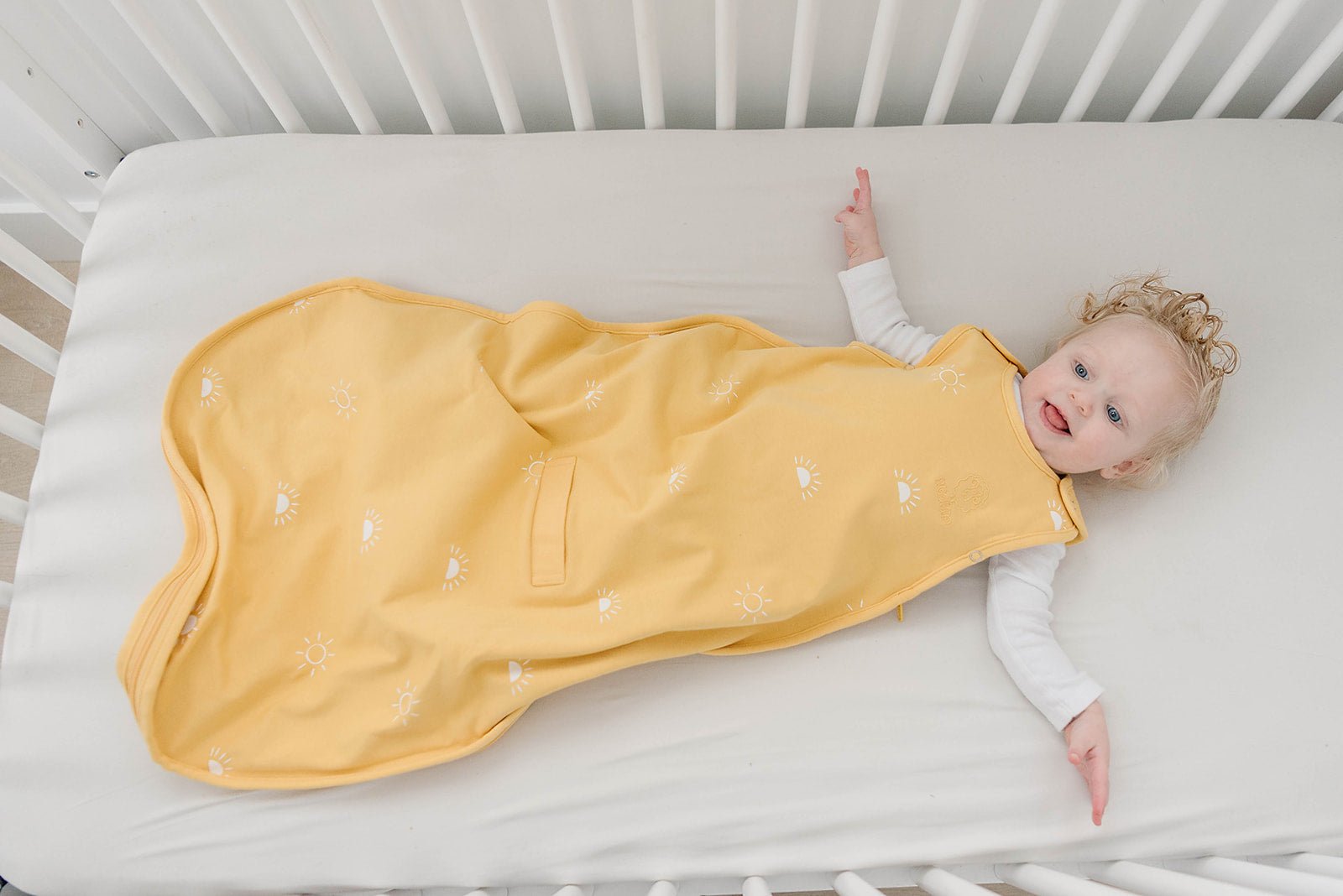
Ah, autumn—the season of crunchy leaves and pumpkin spice lattes.
TOG Recommendations: A 1.0 TOG or 2.5 TOG sleeping sack, depending on the night temperatures.
Material Choices:
- Jersey Cotton: Soft with a slight stretch for comfort.
- Lightweight Fleece: Provides warmth without overheating.
Clothing Underneath:
- Long-sleeve cotton onesie or lightweight pajamas.
Tips:
- Layering is Key: It’s easier to remove a layer if the baby is too warm.
- Check for Drafts: Ensure windows are properly sealed to keep the room at a consistent temperature.
Winter Wonderland
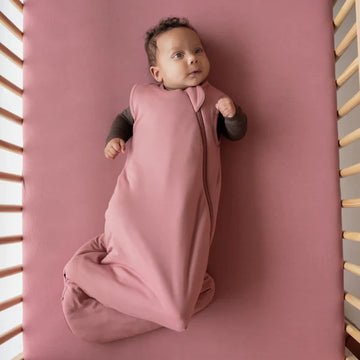
Winter is coming, and so is the need for extra coziness!
TOG Recommendations: A 2.5 TOG or 3.5 TOG sleeping sack for those chilly nights.
Material Choices:
- Quilted Cotton: Offers warmth with breathability.
- Micro-Fleece or Sherpa: Super cozy for the coldest nights.
Clothing Underneath:
- Long-sleeve onesie and footed pajamas.
Tips:
- Avoid Overheating: As tempting as it is to bundle your baby like a marshmallow, too many layers can cause overheating.
- Room Temperature: Aim for 18°C (65°F) for optimal sleep.
Spring Surprises
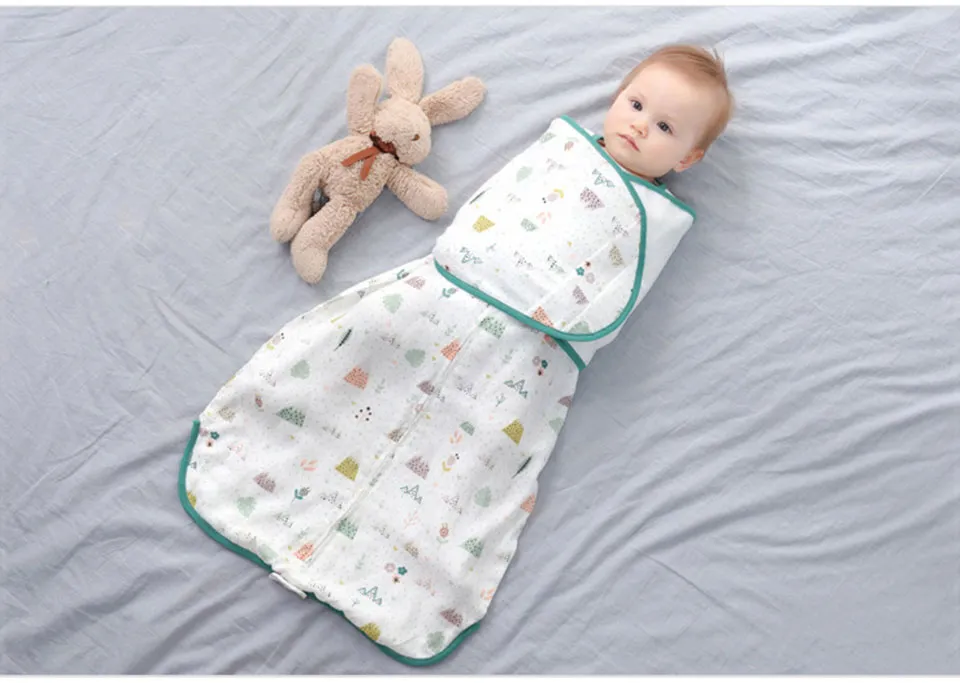
Spring—a season where the weather can’t make up its mind.
TOG Recommendations: A 1.0 TOG sleeping sack is versatile for fluctuating temperatures.
Material Choices:
- Organic Cotton: Gentle on the skin and adaptable to temperature changes.
- Bamboo Blends: Good for temperature regulation.
Clothing Underneath:
- Short or long-sleeve onesie, depending on the night.
Tips:
- Stay Updated on Weather Forecasts: Be prepared to adjust layers accordingly.
- Allergies: Consider hypoallergenic materials if your baby has sensitivities.
Regional Climate Considerations
Not all climates are created equal. Let’s consider some regional differences.
Tropical Climates
- High Humidity and Heat: Stick to 0.5 TOG sleeping sacks year-round.
- Breathable Fabrics: Muslin or bamboo to prevent overheating.
Dry Climates
- Hot Days, Cool Nights: Prepare for temperature drops at night.
- Versatile TOG Choices: Have both 1.0 TOG and 2.5 TOG options.
Cold Climates
- Consistent Chill: A 3.5 TOG sleeping sack may be necessary.
- Layering: Use thermal pajamas underneath for extra warmth.
| Climate | Day Temperature | Night Temperature | Recommended TOG |
|---|---|---|---|
| Tropical | 30°C+ | 24-26°C | 0.5 TOG |
| Desert | 35°C+ | 10-15°C | 1.0 – 2.5 TOG |
| Temperate | 20-25°C | 10-20°C | 1.0 – 2.5 TOG |
| Polar | Below 0°C | Well below 0°C | 3.5 TOG |
Choosing the Right Material
Let’s talk fabric. Because what’s touching your baby’s skin is just as important as the temperature.
Popular Sleeping Sack Materials:
- Cotton
- Pros: Breathable, soft, hypoallergenic.
- Cons: May not wick moisture as effectively.
- Bamboo
- Pros: Highly breathable, moisture-wicking, antibacterial.
- Cons: Can be more expensive.
- Fleece
- Pros: Warm, cozy, quick-drying.
- Cons: Not as breathable, may cause overheating in warmer rooms.
- Merino Wool
- Pros: Regulates temperature, breathable, natural.
- Cons: Higher price point, requires special care.
[Image: Swatches of different sleeping sack materials]
Fun Fact: Bamboo fabric is made from the pulp of bamboo grass—it’s not just for pandas anymore!
Tips for Using Sleeping Sacks in Different Climates
- Always Check Your Baby’s Temperature: Feel the back of their neck or tummy. Hands and feet are not reliable indicators.
- Adjust Layers: It’s easier to adjust your baby’s clothing than to change the room temperature.
- Keep the Crib Bare: No extra blankets or pillows—sleeping sacks provide all the warmth they need.
Do’s and Don’ts
Do:
- Do choose natural fibers for better breathability.
- Do consider your home’s insulation when selecting TOG ratings.
- Do wash sleeping sacks before first use.
Don’t:
- Don’t use a sleeping sack that’s too big—a snug fit around the neck and armholes is safer.
- Don’t overdress your baby under the sleeping sack.
- Don’t forget to adjust the sleeping sack as seasons change.
Care and Maintenance
To keep those sleeping sacks in tip-top shape:
- Washing: Follow the manufacturer’s instructions—usually gentle cycle with mild detergent.
- Drying: Air-drying is best to prevent shrinkage, but low-tumble drying can work for some materials.
- Storage: Store in a cool, dry place. Consider vacuum-sealing off-season sleeping sacks.
Pro Tip: Keep an extra sleeping sack on hand for those unexpected midnight messes. Trust us on this one.
Frequently Asked Questions (FAQs)
1. How do I know if my baby is too hot or too cold?
Check the back of their neck or chest:
- Too Hot: If they’re sweaty or their skin feels hot.
- Too Cold: If their skin feels cool to the touch.
Remember, a baby’s hands and feet are usually cooler and not good indicators.
2. Can I use a sleeping sack with a swaddle?
It’s not recommended to use both simultaneously. Swaddles are for newborns who need that snug feeling while sleeping sacks allow more movement.
3. At what age should I start using a sleeping sack?
Sleeping sacks can be used from birth, but ensure they are the correct size for safety. Once your baby starts showing signs of rolling over, transition to a sleeping sack if you’re swaddling.
4. How many sleeping sacks do I need?
Having at least two per TOG rating is practical—one in use and one spare for those inevitable spits or spills.
5. Are sleeping sacks safe for my baby?
Yes, sleeping sacks are designed to be a safer alternative to loose blankets, reducing the risk of Sudden Infant Death Syndrome (SIDS).
6. Can I use a higher TOG sleeping sack and fewer clothes to save money?
It’s important to match the TOG rating to your room temperature rather than trying to compensate with less clothing. Improper TOG use can lead to overheating or chilling.
Conclusion
Choosing the right sleeping sack for your baby doesn’t have to be rocket or baby science. By understanding the TOG ratings, considering the season, and knowing your regional climate, you can select the perfect sleeping sack to keep your little one comfortable and safe all year round.
And remember, babies may not come with instruction manuals, but they do come with plenty of heartwarming (and sometimes hilarious) moments. So, gear up with the right sleeping sack, and enjoy those precious sleeping baby snuggles—because when the baby sleeps, you sleep!
For more parenting tips, check out our related guides:
Sources:
Happy parenting, and may your coffee be strong and your baby’s naps be long!

